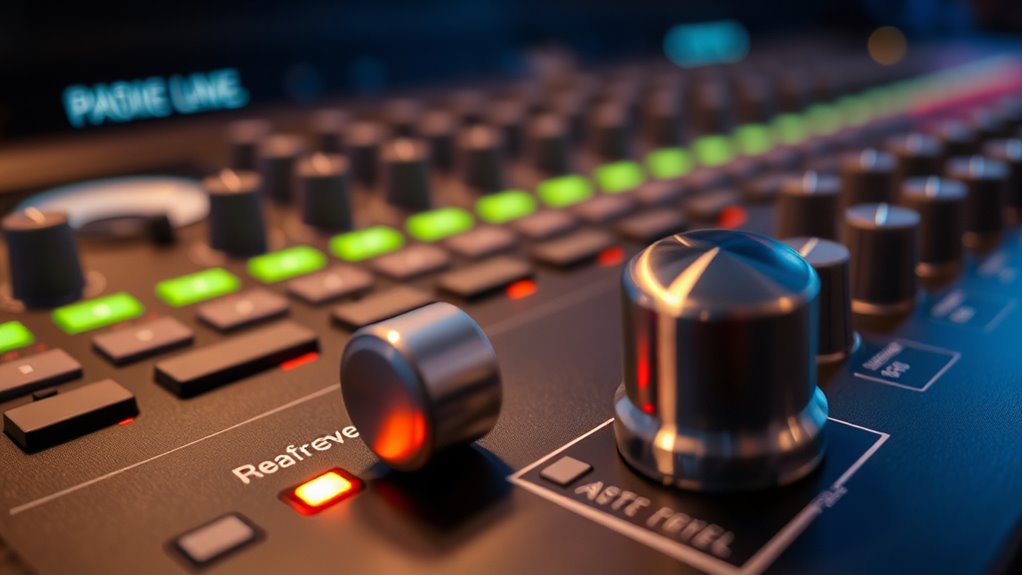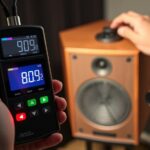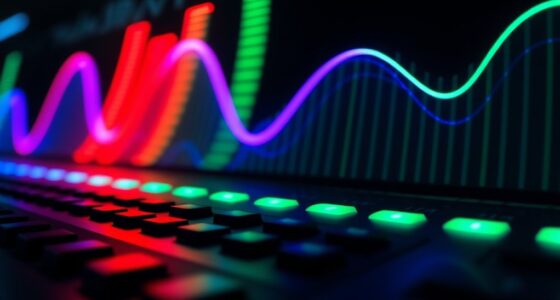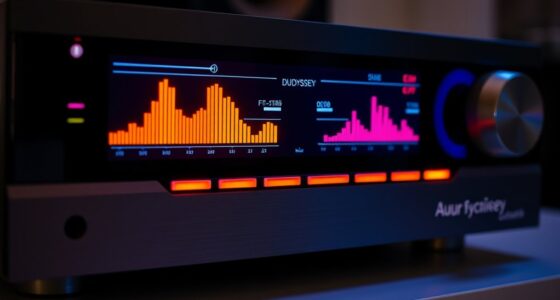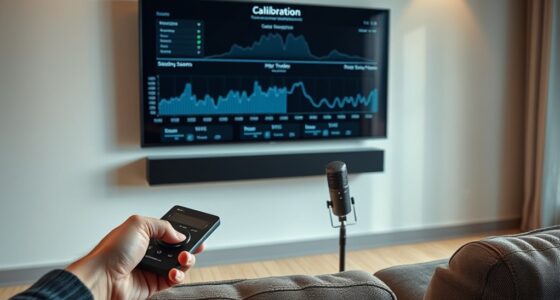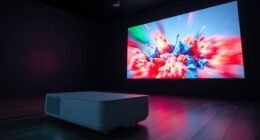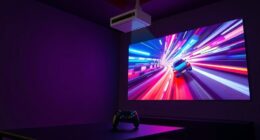The THX reference level is a standard that guarantees your home theater sounds professional and immersive by calibrating at 85 decibels at your listening position. To achieve it, you need to measure the sound level, usually with a calibration microphone or sound meter, and adjust your system until the test tones hit that target. This process creates balanced, clear, and impactful sound. Want to know step-by-step how to set it up perfectly? Keep going for all the details.
Key Takeaways
- THX reference level is a calibration standard set at 85 dB SPL at the listening position for optimal sound clarity.
- Achieve it by using a calibration microphone or sound level meter to measure speaker output during setup.
- Use your AV receiver’s auto-calibration tools or manually adjust speaker volumes to reach 85 dB at the listening area.
- Play test tones and fine-tune speaker levels to ensure balanced, distortion-free sound across all channels.
- Maintaining the THX reference level provides a professional, immersive home theater experience with accurate sound reproduction.

Ever wondered what makes home theater sound truly immersive? It all starts with understanding the THX reference level, a benchmark that guarantees your audio experience meets professional standards. Achieving this level isn’t about cranking your volume to the max; instead, it involves a precise calibration process that aligns your system with an established audio standard. This process is vital because it guarantees that every sound, from whispering dialogue to explosive bass, reaches the intended intensity without distortion or imbalance. When you calibrate your system correctly, you’re fundamentally setting a consistent reference point, allowing for accurate and dynamic sound reproduction that closely mirrors what the filmmakers envisioned.
The calibration process begins with measuring your room’s acoustics and speaker placement, which greatly influence sound quality. Using a sound level meter or calibration microphone, you’ll need to play test tones that help you adjust your receiver’s settings. This step guarantees each speaker is producing the correct volume relative to the others, creating a balanced soundstage. The goal here is to bring your system in line with the audio standard that defines the THX reference level—typically set at 85 decibels at the listening position. This level isn’t arbitrary; it’s a carefully chosen loudness that offers the best balance between clarity and impact, ensuring you experience movies as they’re meant to be heard. Calibration accuracy is essential for achieving optimal sound performance.
Once you’ve calibrated your system to this standard, you’ll notice a marked difference in how movies sound. Dialogue becomes clearer, sound effects more precise, and bass tighter, all without overwhelming the overall mix. Achieving the THX reference level isn’t just about loudness—it’s about maintaining fidelity at a specific calibrated volume, so you get consistent sound regardless of the content. Many modern AV receivers have built-in calibration tools or auto-setup features that simplify this process, but manual adjustments often produce more accurate results. Remember, the key is patience and attention to detail during the calibration process, as small tweaks can make a meaningful difference.
In the end, reaching the THX reference level means your home theater system is performing at a professional standard, delivering a cinematic experience that’s immersive and true to the original sound design. It’s about creating a balanced, clear, and dynamic sound environment where every movie scene feels authentic and engaging. So take the time to calibrate properly, follow the audio standard, and enjoy the full potential of your home theater system—because nothing beats a precisely calibrated setup when it comes to immersive sound.
Frequently Asked Questions
How Does Room Acoustics Affect Achieving THX Reference Levels?
Room acoustics considerably impact your ability to achieve THX reference levels. Excessive room reflections can cause sound distortion, making it harder to reach accurate volume levels. Proper speaker placement helps minimize reflections and optimizes sound clarity. By controlling reflections and strategically positioning your speakers, you create a balanced acoustic environment that allows you to accurately hit those reference levels without distortion or loss of detail.
Can Consumer Audio Equipment Reliably Reach THX Reference Levels?
You can’t always rely on consumer audio equipment to reach THX reference levels, especially if your speaker placement isn’t ideal or your amplifier power is inadequate. Proper speaker placement ensures sound clarity and volume, while a powerful enough amplifier provides the headroom needed for maximum output. Without these, even high-quality gear may struggle to reliably hit THX reference levels, so upgrades or adjustments are often necessary for true performance.
What Are Common Mistakes When Calibrating for THX Reference?
You might think calibration software alone guarantees perfect levels, but improper speaker placement is a common mistake. Always position your speakers correctly before calibration. Avoid relying solely on automated tools; use manual adjustments afterward. Neglecting room acoustics and not calibrating at the correct volume level can also lead to inaccuracies. Ensuring proper speaker placement and fine-tuning with calibration software will help you reach the true THX reference level.
How Do THX Reference Levels Impact Overall Sound Quality?
You notice that setting the THX reference level guarantees consistent sound quality, making your audio experience more immersive. Proper speaker placement and listener positioning are essential; they help maintain accurate sound levels and clarity. When these elements are optimized, you’ll experience balanced bass, clear dialogue, and a broader soundstage. This meticulous calibration prevents distortion, allowing you to enjoy movies and music at their intended dynamic range, enhancing overall sound quality.
Are There Specific Tools Recommended for Precise Calibration?
You’ll want to use calibration software paired with measurement microphones for precise calibration. Studies show that proper calibration can improve sound accuracy by up to 30%. Popular tools include REW (Room EQ Wizard) and AudioTools, which offer detailed analysis. These tools help you fine-tune your system to match the THX reference level, ensuring the best sound quality and a balanced listening experience.
Conclusion
Reaching the THX reference level is like tuning your home theater to a perfect symphony—every sound harmonizes just right, filling your space with immersive clarity. When you hit that target, your audio becomes a vibrant painting, bursting with detail and depth. It’s the secret ingredient that transforms ordinary movie nights into unforgettable journeys. Keep dialing in those settings, and soon you’ll be sailing on a sea of crystal-clear sound, where every note feels within arm’s reach.
